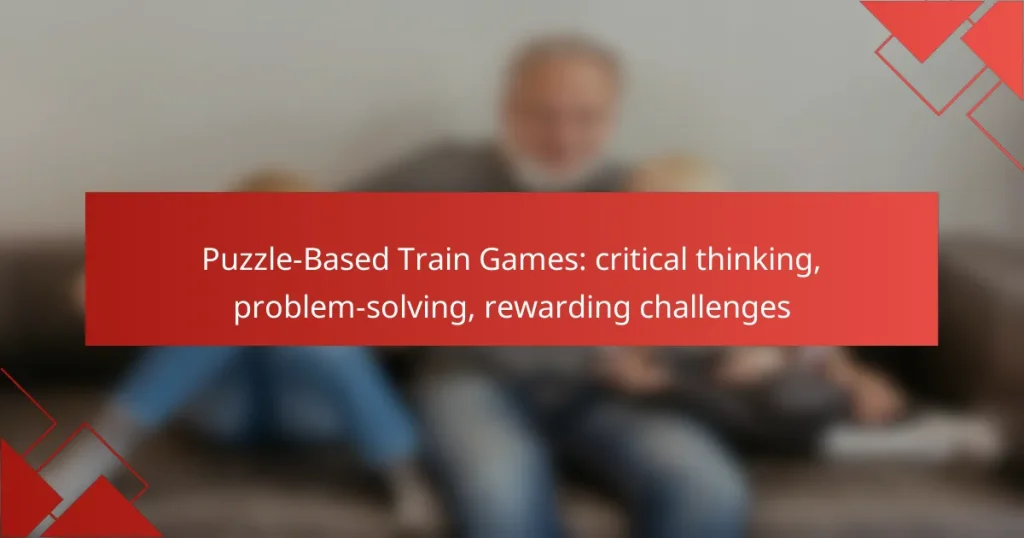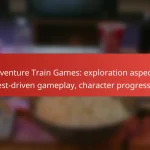Puzzle-based train games provide an engaging platform for enhancing critical thinking and problem-solving skills. Players are challenged to strategize, plan routes, and tackle logistical puzzles, fostering creativity and adaptability. With rewarding challenges that require quick decision-making, these games serve as excellent tools for developing a deeper understanding of problem-solving dynamics.

What are the best puzzle-based train games for critical thinking?
The best puzzle-based train games for critical thinking challenge players to strategize, plan routes, and solve logistical problems. These games often require players to think ahead, manage resources, and adapt to changing conditions, making them excellent tools for developing problem-solving skills.
Ticket to Ride
Ticket to Ride is a popular board game where players collect train cards to claim railway routes across a map. The objective is to connect cities and complete destination tickets for points. Players must balance between expanding their routes and blocking opponents, which adds a layer of strategic thinking.
Consider starting with the basic rules and gradually introducing expansions for more complexity. The game is accessible for all ages, making it a great choice for family game nights.
Railroad Tycoon
Railroad Tycoon is a simulation game that allows players to build and manage their own railway company. Players must strategize to lay tracks, manage finances, and compete against other companies. The game emphasizes economic decision-making and resource management, requiring players to think critically about their investments.
Focus on balancing expansion with profitability. Understanding market trends and adjusting your strategy accordingly can significantly enhance your success in the game.
TransAmerica
TransAmerica is a streamlined game where players aim to connect their cities across the United States. Each player has a network of cities and must build tracks to connect them, all while managing limited resources. The simplicity of the rules allows for quick gameplay, but strategic depth emerges as players compete for routes.
Be mindful of your opponents’ goals while planning your connections. Blocking others can be just as important as completing your own routes, adding an engaging layer of competition.
Steam
Steam is a strategic train game where players build rail networks and deliver goods to various cities. Players must manage their resources effectively, balancing track construction with the transportation of goods for profit. The game encourages critical thinking as players must adapt to the evolving market demands.
Consider focusing on efficient routes and timely deliveries to maximize your earnings. Watch for opportunities to expand your network while keeping an eye on your competitors’ movements.
Russian Railroads
Russian Railroads is a complex strategy game that combines route building and resource management. Players develop their railroads across Russia, upgrading their trains and expanding their networks to earn points. The game requires careful planning and prioritization of actions to optimize scoring potential.
Utilize a balanced approach by investing in both train upgrades and track expansion. Pay attention to the scoring opportunities available each round to maximize your overall strategy.

How do puzzle-based train games enhance problem-solving skills?
Puzzle-based train games significantly enhance problem-solving skills by challenging players to think critically and creatively. These games require players to analyze situations, devise strategies, and make decisions under pressure, fostering a deeper understanding of problem-solving dynamics.
Encourages strategic planning
Strategic planning is essential in puzzle-based train games, as players must anticipate future challenges and devise effective routes or solutions. For instance, players might need to allocate resources wisely or choose optimal paths to avoid obstacles, which sharpens their ability to think ahead.
To improve strategic planning skills, players can practice by breaking down complex puzzles into manageable parts. This method allows them to focus on individual components before integrating them into a cohesive strategy.
Improves spatial awareness
Puzzle-based train games often require players to visualize routes and spatial relationships between different elements. This engagement enhances spatial awareness, as players must navigate tracks, manage train placements, and foresee the impact of their movements.
To boost spatial awareness, players can engage in exercises that involve mapping out routes on paper or using digital tools. Regular practice in these games can lead to improved navigation skills in real-life scenarios, such as driving or architecture.
Fosters teamwork and communication
Many puzzle-based train games are designed for multiple players, promoting teamwork and communication. Collaborating with others to solve puzzles encourages players to share ideas, negotiate strategies, and build consensus, which are vital skills in both personal and professional settings.
To maximize teamwork benefits, players should establish clear roles based on individual strengths and maintain open lines of communication throughout the game. This approach not only enhances the gaming experience but also translates to better collaboration in real-world tasks.

What are the rewarding challenges in puzzle-based train games?
Puzzle-based train games offer rewarding challenges that engage players in critical thinking and problem-solving. These games often require strategic planning and quick decision-making to navigate complex scenarios effectively.
Complex routes and logistics
Managing complex routes and logistics is a central challenge in puzzle-based train games. Players must design efficient train paths that consider various factors such as terrain, station locations, and potential obstacles. For instance, players might need to connect multiple cities while minimizing travel time and maximizing cargo delivery.
Understanding the layout of the game map is crucial. Players should analyze the best routes to avoid congestion and delays, often requiring them to reroute trains dynamically based on changing conditions. This aspect not only tests spatial awareness but also enhances strategic thinking.
Resource management tasks
Resource management is another key challenge in these games, where players must balance the acquisition and allocation of resources like fuel, money, and train cars. Effective management ensures that trains run smoothly and meet delivery deadlines. Players often face decisions about investing in upgrades or expanding their network, which can significantly impact their overall success.
To excel, players should prioritize resource allocation based on immediate needs and long-term goals. For example, investing in faster trains might yield quicker deliveries, but it could also deplete funds needed for essential upgrades. Keeping an eye on resource levels and adjusting strategies accordingly is vital for success.
Time-based challenges
Time-based challenges add an extra layer of excitement and urgency to puzzle-based train games. Players often have a limited time to complete specific tasks, such as delivering cargo or connecting stations, which requires quick thinking and efficient planning. These challenges can range from a few minutes to several hours, depending on the game’s design.
To succeed in time-based scenarios, players should develop a clear plan before starting and practice quick decision-making. Utilizing shortcuts and optimizing train schedules can help meet tight deadlines. Additionally, players should be aware of potential pitfalls, such as overcommitting resources, which can lead to delays and missed targets.

What criteria should you consider when choosing a puzzle-based train game?
When selecting a puzzle-based train game, consider factors such as player age, skill level, game duration, and complexity. These criteria will help ensure that the game is engaging and suitable for the intended audience.
Player age and skill level
Understanding the player age and skill level is crucial for choosing an appropriate puzzle-based train game. Games designed for younger audiences often feature simpler mechanics and more visual cues, while those aimed at adults may involve more complex problem-solving and strategic thinking.
For example, a game suitable for children aged 6-10 might include colorful graphics and straightforward puzzles, while a game for teens or adults could present intricate challenges requiring critical thinking and advanced planning. Always check the recommended age range on the game packaging or description.
Game duration and complexity
Game duration and complexity significantly impact player engagement. Shorter games, typically lasting 20-30 minutes, are ideal for casual play, while longer games may offer deeper challenges and require more commitment, often spanning 60 minutes or more.
Consider the complexity of the puzzles as well. A game with low complexity may be suitable for quick sessions and beginners, while those with high complexity can provide rewarding challenges for experienced players. Look for games that offer varying levels of difficulty to accommodate different skill sets and preferences.

What are the emerging trends in puzzle-based train games?
Emerging trends in puzzle-based train games focus on enhancing player engagement through innovative technologies and gameplay mechanics. These trends include the integration of augmented reality, which enriches the gaming experience by blending digital elements with the real world, and the use of complex narratives that challenge players’ critical thinking and problem-solving skills.
Integration of augmented reality
Augmented reality (AR) is becoming a key feature in puzzle-based train games, allowing players to interact with virtual puzzles overlaid on their real environment. This technology enhances immersion, making players feel as though they are part of the game world, which can lead to more engaging and rewarding challenges.
To effectively implement AR in train games, developers must consider user accessibility and device compatibility. Popular mobile platforms, such as iOS and Android, support AR features, but ensuring a smooth experience across various devices is crucial. Games like “Train Valley” have started to incorporate AR elements, allowing players to visualize train routes and puzzles in their physical space.
When designing AR puzzles, focus on intuitive interactions that do not overwhelm players. Simple gestures, such as tapping or swiping, can enhance the gameplay experience without complicating it. Avoid overly complex setups that may frustrate users, and ensure that the puzzles are rewarding and solvable within a reasonable time frame.


